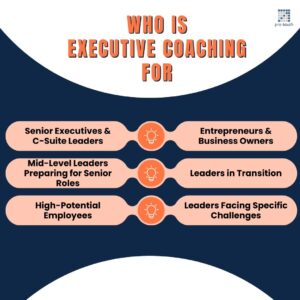Executive coaching is for Individuals in Leadership or high-responsibility roles who want to improve their effectiveness, decision-making, and impact. In short—executive coaching is not just for those at the very top; it’s for anyone in a leadership position who needs a structured, confidential space to grow, reflect, and perform at their best.
It’s most commonly aimed at:

a. Senior Executives & C-Suite Leaders:
benefit from executive coaching, ICF Certification, ICF coach training because they operate at the highest strategic level, where the stakes are high, decisions are complex, and isolation can be a real challenge. CEOs, CFOs, COOs, and other top-level leaders who need to navigate complex challenges, drive strategy, and inspire teams. Common Coaching Goals for this group: Strategic Clarity – refining vision, mission, and long-term direction. Executive Presence – building credibility, influence, and gravitas. Decision-Making Under Pressure – balancing speed with thorough analysis. Leading Organizational Change – guiding teams through transformation with minimal disruption. Stakeholder Management – navigating boards, investors, and senior peers effectively. Work–Life Integration – preventing burnout and sustaining energy over the long term.
b. Mid-Level Leaders Preparing for Senior Roles:
are often in the “stepping stone” stage — they’ve proven themselves in operational or functional leadership, but now need to develop the vision, influence, and strategic mindset required at the executive level. Managers or directors on the path to executive positions who need to sharpen leadership, communication, and strategic thinking skills with the help of Executive coaching, ICF Certification and ICF coach training. Common Coaching Goals for this group: Strategic Thinking – shifting focus from daily operations to big-picture impact. Cross-Functional Influence – collaborating beyond their department to drive enterprise-wide initiatives. Leadership Presence – strengthening communication, confidence, and credibility with senior stakeholders. Change Leadership – learning to guide teams through uncertainty and transformation. Decision-Making Maturity – balancing risks, resources, and long-term outcomes. Self-Management – managing stress, setting boundaries, and avoiding burnout as responsibilities grow.
c. High-Potential Employees (“HiPos”):
are individuals identified by the organization as having the capability, ambition, and readiness to take on significantly greater leadership responsibilities in the near future. They’re often groomed for senior roles through targeted development programs, with executive coaching as a core component. Rising stars identified by the organization for future leadership roles, often receiving coaching as part of succession planning. Common Coaching Goals for HiPos: Accelerated Leadership Development – building advanced skills faster to prepare for bigger roles. Broader Business Acumen – understanding strategy, finance, and cross-functional dynamics. Self-Awareness & Emotional Intelligence – recognizing strengths, addressing blind spots, and managing relationships effectively. Influence Without Authority – learning to lead peers and senior stakeholders without formal power. Confidence in Ambiguity – making decisions and taking initiative in uncertain environments. Career Path Planning – clarifying long-term aspirations and aligning them with organizational needs.
d. Entrepreneurs & Business Owners:
often wear multiple hats — strategist, operator, marketer, and problem-solver — all while carrying the weight of business survival and growth. Executive coaching gives them a structured space to step back, think strategically, and lead more effectively. Founders seeking clarity, better delegation, or strategies for scaling without burnout. Common Coaching Goals for Entrepreneurs & Business Owners: Vision & Growth Strategy – clarifying long-term direction and scaling sustainably. Delegation & Team Building – shifting from “doing everything” to empowering capable teams. Decision-Making Clarity – balancing gut instinct with data-driven choices. Time & Energy Management – preventing burnout while staying productive. Leadership Brand – shaping how they’re perceived by employees, investors, and partners. Adaptability – navigating rapid market changes and uncertainty.
e. Leaders in Transition:
are individuals stepping into a new role, environment, or phase of leadership — situations where expectations are high, uncertainty is high, and the margin for error can be small. Executives taking on a new role, entering a new market, or leading through mergers, acquisitions, or restructuring. Common Coaching Goals for Leaders in Transition: First 90-Day Strategy – creating an impactful entry plan to establish credibility quickly. Cultural Adaptation – understanding and aligning with a new organizational or market culture. Stakeholder Alignment – building strong relationships with boards, peers, and key influencers early on. Role Clarity – defining priorities and boundaries in a new scope of responsibility. Change Navigation – leading teams smoothly through restructures, mergers, or pivots. Confidence & Resilience – managing the stress and ambiguity that comes with change.
f. Leaders Facing Specific Challenges:
are individuals whose performance or impact is being affected by a defined set of issues — often urgent, complex, or highly visible — that require targeted development and problem-solving. Those struggling with team alignment, communication breakdowns, decision fatigue, or organizational politics. Common Coaching Goals for this group: Conflict Resolution – addressing tensions with peers, teams, or stakeholders constructively. Team Alignment – rebuilding trust, collaboration, and morale. Performance Turnaround – overcoming declining results or stalled initiatives. Decision Fatigue Management – streamlining priorities to avoid burnout and indecision. Political Savvy – navigating organizational dynamics without damaging integrity. Communication Reset – improving clarity, listening skills, and message impact.
Conclusion
Executive coaching is not a “one-size-fits-all” tool — it’s a personalized development partnership designed to meet leaders exactly where they are. Whether it’s C-Suite executives refining their vision, mid-level leaders preparing for bigger roles, high-potential employees accelerating their growth, entrepreneurs building sustainable businesses, leaders navigating transitions, or those facing specific challenges, coaching provides a confidential, structured space to think, adapt, and lead with greater clarity and confidence.
Ultimately, executive coaching equips leaders to not only perform better but also to lead with impact, ensuring that both they and their organizations thrive in complex, fast-changing environments.





Leave a Reply